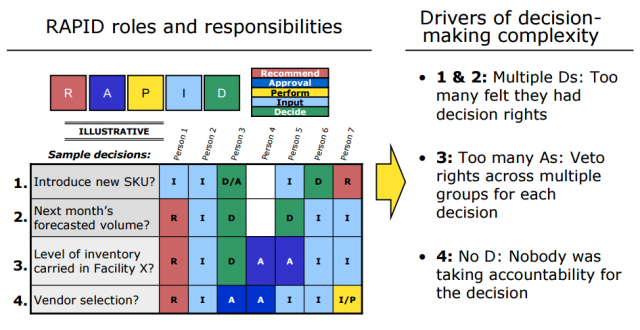A useful tool to zero in on decision-making problems and create higher-yielding change programs is a decision management tool we call RAPID. The idea is to clearly map out who plays what role in each critical decision and use that to enable swift decisions, without endless debates, second-guessing or pocket vetoes. It determines the captain of the boat, so to speak, but in a more nuanced way that deals with the different teams needed for different problems.
To try this approach, start by writing down 10 to 20 of the critical decisions that have to be made on a regular basis and that are fundamental to supply chain performance. It can include questions like: “Should we introduce a new SKU? What is our forecasted volume for next month? or What level of product Y inventory should I carry in facility X?” Then, use a grid to identify all the management positions that touch that decision and assign a letter indicating their role today. R = recommend, A = approve/veto, D = decide/choose, I = inform, P = perform/execute after the decision.
Most companies find that the RAPID process is a stunning way to highlight the problem we call “Who has the D?” On many important decisions, there typically is either no one with formal authority to decide, or more often several people who each think they get to choose and who end up interfering with each other. The result is endless meetings, decisions that are delayed or don’t stick and a slow pace of change.
The solution is simple: Rewrite the map, and for every decision, make sure there is no more than one D and no more than one A. Eliminate any unnecessary input. Then publish this document and distribute it throughout your organization.
Source: “Pulling Away: Managing and Sustaining Change”
Original Publication: Bain
Subjects: Management, Organizational Behavior
Click to Add the First »

